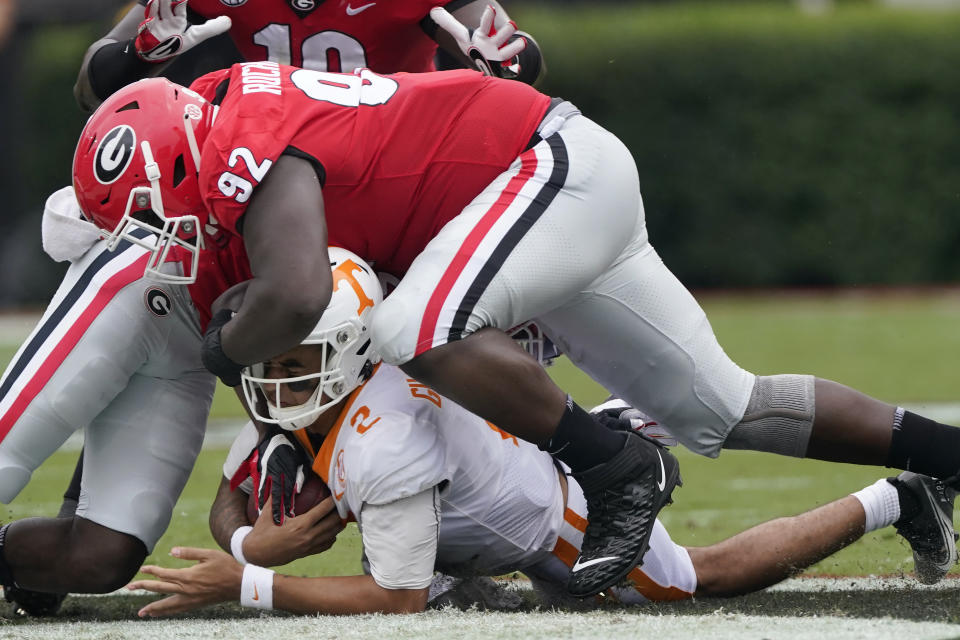Monday measure: Will LSU go down as the worst defending champ of the modern era?
Defending champions rarely have bad follow-up seasons.
That’s a big reason why it’s so striking that LSU sits at 1-2 through the first three weeks of the SEC season. The Tigers fell below .500 after a 45-41 loss to Missouri on Saturday when Mizzou stopped LSU on four straight plays at the 1-yard line with less than a minute left.
Yeah, the Tigers lost a lot of talent from their title-winning team. Terrace Marshall Jr. is the only key offensive contributor who returned in 2020. But a lot of us thought that there was plenty of talent in Baton Rouge to keep the Tigers afloat near the top of the SEC West in 2020.
Instead, LSU is looking a lot like 2011 Auburn. After those Tigers won the national title season and Cam Newton went to the NFL, Auburn fell to 8-5 in 2011. That’s the worst campaign for a defending national champion in the past 10 years. By far. No defending champ since the 2011 Auburn team has lost more than two games.
2011 Auburn: 8-5
2012 Alabama: 13-1
2013 Alabama: 11-2
2014 Florida State: 13-1
2015 Ohio State: 12-1
2016 Alabama: 14-1
2017 Clemson: 12-2
2018 Alabama: 14-1
2019 Clemson: 14-1
Newton was the No. 1 overall pick in the 2011 NFL draft. Joe Burrow was the No. 1 overall pick in the 2020 NFL draft. There is some similarity.
LSU fans may notice another similarity too. LSU finished 8-5 in 2008 after winning the 2007 national title. That 2008 team went just 3-5 in the SEC and lost to Florida, Georgia, Alabama, Ole Miss and Arkansas. Three of those opponents were ranked in the top 15 at the time of the loss.
It’s easy to see how LSU could embark on a 5-5 campaign in the SEC this year, especially with a defense playing this poorly. After Florida, the Tigers still have to play Alabama, Texas A&M and Auburn. All three of those teams are currently ranked in the top 15. Oh, and Ole Miss and Arkansas have shown that they’re no gimmes either.
If LSU finishes at 5-5 or worse, it will have a case to be called the worst defending champion in modern college football history.
— Nick Bromberg

Oklahoma and Texas are struggling, but it’s worse for Texas
Oklahoma’s 53-45 four-overtime win over Texas on Saturday was certainly one of the most entertaining games of the 2020 season thus far, but it gained heightened attention because it was a rivalry game between two blue-blood programs.
In reality, though, it was a game between two average-at-best Big 12 teams.
Oklahoma has won five straight Big 12 titles, but looks like a team in the early throes of a rare rebuilding year. The Sooners, in Year 4 under Lincoln Riley, improved to 2-2 on Saturday despite blowing a fourth-quarter lead for the third time this year. OU is working in a redshirt freshman quarterback in Spencer Rattler and an array of other new faces on offense to replace the barrage of skill position talent that has been on display in Norman in recent seasons. Not to mention, some of the players OU expected to rely on — on both sides of the ball — have not been on the field under various circumstances (injury, suspension, opt-out, etc).
What I’m saying is it’s easier to excuse Oklahoma for taking a step back when it has five straight conference titles and five straight College Football Playoff appearances under its belt.
For Texas, the excuses are much more difficult to accept. Tom Herman talked a big game when he was hired ahead of the 2017 season. Has he elevated the program from what it was under Charlie Strong? Sure. But a 27-17 overall record with an 18-12 mark in Big 12 play is not what Herman is being paid $6.5 million per year to do.
The 10-win triumph in 2018 that was capped off by a Sugar Bowl win over Georgia was supposed to be a sign of things to come. Since then, however, Texas is 10-7 overall and 6-6 in the Big 12. UT went 8-5 last year with losses to teams TCU, Iowa State and Baylor along the way.
Entering 2020, though, many thought this could be the year Texas finally found itself atop the Big 12. After all, the team was returning 16 starters, including senior quarterback Sam Ehlinger in his fourth year as the Longhorns’ QB1. But all of that returning experience has not shown on the field.
UT needed a ferocious late-game rally and overtime just to beat a mediocre Texas Tech team, 63-56. That startling performance was a sign of things to come as losses to TCU and Oklahoma followed to drop the Longhorns to 2-2 on the year.
In those games, Texas has been plagued by turnovers, penalties, poor tackling and special teams issues while struggling at positions (wide receiver, offensive line) that one would think would be solidified in the fourth year of Herman’s tenure.
Through three weeks of play, Oklahoma State, Iowa State and Kansas State are the only Big 12 teams without a conference loss. The race for the Big 12 crown is still wide open, but Texas finds itself with significant ground to make up. At this point in the Herman era, it’s not a position Texas fans expected to find themselves in.
- Sam Cooper

In appreciation of Travis Etienne
Don’t let Trevor Lawrence’s status as the presumptive No. 1 pick in the 2021 NFL draft distract you from Travis Etienne’s greatness.
Etienne made the surprising decision to come back to Clemson for his senior season in 2020 and has been magnificent so far. He had 17 carries for 149 yards and two touchdowns along with eight catches for 73 yards in the Tigers’ blowout win over Miami. And he produced some highlight-reel stuff.
Travis Etienne is just different, or as we say... Uncommon.
⛽️ @swaggy_t1 pic.twitter.com/uMHMX2dm8C— Clemson Football (@ClemsonFB) October 11, 2020
If that sprint down the sideline wasn’t enough for you, how about this hurdle?
This run by Travis Etienne...
Goodness.
Watch live on ABC or here: https://t.co/lu6NuCdXJ2 pic.twitter.com/rdEHWCtGPD— Clemson Football (@ClemsonFB) October 11, 2020
Etienne has 4,430 career rushing yards and is just 173 yards away from breaking the ACC career rushing mark held by NC State’s Ted Brown. He’ll likely have that record to himself in a couple of weeks and could end up putting the career rushing mark in the conference incredibly out of reach by the time Clemson’s season is over.
Etienne isn’t a product of a ton of carries either. He’s had no more than 207 carries in a single season and his 7.0 yards per carry average in 2020 is the lowest single-season mark of his career. He averaged 7.2 yards per carry as a freshman, 8.1 yards a carry as a sophomore when Clemson won the national title in 2018 and 7.8 yards a carry in 2019.
Yet Etienne has never gotten any Heisman love despite those gaudy yards per carry numbers. He hasn’t finished any higher than seventh in the Heisman voting and was ninth in 2019.
That’s what happens when you play with a great quarterback like Lawrence. But Etienne is a great college running back. We should all take a moment and appreciate that.
Georgia’s second-half defensive dominance
To call Georgia’s defense dominant would be an understatement.
The Bulldogs currently rank No. 2 nationally in total defense, allowing only 236.7 yards per game. The only team ahead of UGA is Houston, a team that has played just one game and allowed just 211 yards in a win over Tulane.
Georgia, though, has done its work against three SEC foes: Arkansas, Auburn and Tennessee. And the Bulldogs have turned up the intensity on defense in the second half especially.
In its 3-0 start, Georgia has allowed a total of 37 points (though 7 of those points came via an offensive blunder). Of those 37 points, just six of those points have been scored in the second half, including zero in the fourth quarter.
Saturday’s win over Tennessee was a perfect example of that second-half domination. The Bulldogs actually trailed 21-17 at halftime, but the defense completely shut down the Vols over the final two quarters. During the second half, Georgia allowed Tennessee’s offense to gain just 56 yards on 39 plays. Tennessee also turned the ball over three times, punted three times and had a turnover on downs. Along the way, the score Georgia finished the game on a 27-0 scoring run.
In Georgia’s first game, it surprisingly fell behind Arkansas 7-5 at halftime, only to rally for a 37-10 win. UGA allowed Arkansas to gain just 115 yards and score only three points in the second half.
In the next week’s 27-6 win over Auburn, UGA allowed only three points and 119 yards on 38 plays in the second half.
Cumulatively in three games, the second-half numbers are staggering: six points allowed in six quarters and 290 yards allowed on 110 plays. That’s just 2.64 yards per play. On top of that, Georgia has forced seven punts, intercepted four passes, registered 10 sacks, scored two touchdowns, recovered two fumbles and forced two turnovers on downs.
That is sheer dominance. But the challenge increases massively next week with a trip to Tuscaloosa to play No. 2 Alabama on tap on Saturday. Following the 63-48 win over Ole Miss, Alabama is averaging 51 points per game. That’s No. 1 in the nation.

More from Yahoo Sports:


